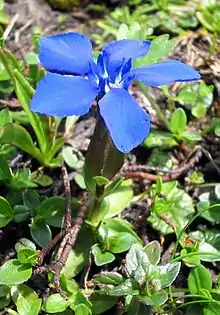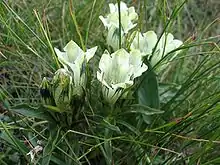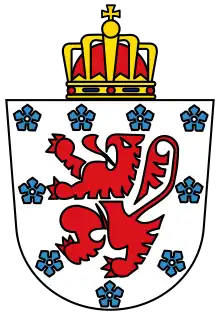| Gentiana | |
|---|---|
 | |
| Gentiana verna | |
| Scientific classification | |
| Kingdom: | Plantae |
| Clade: | Tracheophytes |
| Clade: | Angiosperms |
| Clade: | Eudicots |
| Clade: | Asterids |
| Order: | Gentianales |
| Family: | Gentianaceae |
| Tribe: | Gentianeae |
| Subtribe: | Gentianinae |
| Genus: | Gentiana L. |
| Type species | |
| Gentiana lutea L. | |
| Species | |
|
See text | |
| Synonyms[1] | |
|
List
| |
Gentiana (/ˌdʒɛntʃiˈeɪnə/)[2] is a genus of flowering plants belonging to the gentian family (Gentianaceae), the tribe Gentianeae, and the monophyletic subtribe Gentianinae. With about 400 species, it is considered a large genus. Gentians are notable for their mostly large trumpet-shaped flowers, which are often of an intense blue hue.[3]
The genus name is a tribute to Gentius, an Illyrian king who may have discovered tonic properties in gentians.[4]
Habitat
This is a cosmopolitan genus, occurring in alpine habitats in temperate regions of Asia, Europe and the Americas. Some species also occur in northwestern Africa, eastern Australia, and New Zealand. They are annual, biennial, and perennial plants. Some are evergreen, others are not.
Many gentians are difficult to grow outside their wild habitat, but several species are available in cultivation. Gentians are fully hardy and can grow in full sun or partial shade. They grow in well-drained, neutral-to-acid soils rich in humus. They are popular in rock gardens.
Uses
Many beverages are made with gentian root.[5] Gentiana lutea is used to produce gentian, a distilled beverage produced in the Alps and in the Auvergne.[6] Some species are harvested for the manufacture of apéritifs, liqueurs, and tonics.
Gentian root is a common beverage flavouring for bitters. The soft drink Moxie contains gentian root.[7] The French apéritif Suze is made with gentian. Americano apéritifs contain gentian root for bitter flavoring.[8] It is an ingredient in the Italian liqueur Aperol. It is also used as the main flavor in the German after-dinner digestif called Underberg, and the main ingredient in Angostura bitters and Peychaud's Bitters.
The bitter principle of gentian root is primarily gentiopicrin (also called gentiopicroside),[9] a glycoside. A 2007 paper by a Japanese group identified 23 compounds in fresh gentian root.[10] Gentiopicrin was absent from fresh root, so it possibly develops during drying and storage of the root.
Gentian has had a limited use in perfumery, most notably as a glycerine soap (Crabtree & Evelyn) and a perfume (Corday's Possession, 1937).
Pharmacological uses
Great yellow gentian (Gentiana lutea) is used in herbal medicine for digestive problems, fever, hypertension, muscle spasms, parasitic worms, wounds, cancer, sinusitis, and malaria,[11] although studies have shown minimal efficacy beyond that of a placebo with regard to the treatment of anxiety and ADHD in children.[12][13][14] It has been studied and proven in effectively managing dyspepsia.[15]
Gentiana punctata leaves and roots have been used in traditional Austrian medicine internally and externally as liqueur or tea for disorders of the gastrointestinal tract, skin, locomotor system, liver and bile, and for pediatric problems, fever, flu, rheumatism, and gout.[16]
Gentiana purpurea, Gentiana punctata, and Gentiana pannonica are used to produce gentian schnapps, traditionally used as a digestive aid. In Ayurvedic medicine the endangered Indian gentian Gentiana kurroo has been used as a medical herb, but has been replaced with the Himalayan plant Picrorhiza kurroa, Plantaginaceae or Picrorhiza scrophulariiflora (胡黃蓮 Hú Huáng Lián) from traditional Chinese medicine.
Symbolism

The gentian flower was used as the emblem of the Minamoto clan, one of the four great clans that dominated Japanese politics during the Heian period and went on to establish the first Shogunate in the aftermath of the Genpei War. It is the official flower (called Enzian) of the German-speaking community of Belgium.
Species
General
Gentians have oppositely arranged leaves, sometimes in a basal rosette. The trumpet-shaped flowers are usually deep blue or azure, but can be white, cream, yellow, or red. Many species are polymorphic with respect to flower color, bearing flowers of different colors. Blue-flowered species predominate in the Northern Hemisphere, with red-flowered species dominant in the Andes, where bird pollination is probably more often favored by natural selection. White-flowered species are scattered throughout the range of the genus but dominate in New Zealand. Most flowers are pentamerous, with five lobes in the corolla and five sepals. A few species have four to seven flower parts. The corolla has folds called plicae between the lobes. The style is short or absent. The ovary is mostly sessile and has nectary glands.
List of accepted species
- Gentiana acaulis – stemless gentian
- Gentiana affinis – pleated gentian
- Gentiana alata
- Gentiana alba – plain gentian
- Gentiana albicalyx
- Gentiana albomarginata
- Gentiana algida – whitish gentian
- Gentiana alii
- Gentiana alpina – alpine gentian
- Gentiana alsinoides
- Gentiana altigena
- Gentiana altorum
- Gentiana amplicrater
- Gentiana andrewsii – closed bottle gentian
- Gentiana angustifolia
- Gentiana anisostemon
- Gentiana aperta
- Gentiana apiata
- Gentiana aquatica
- Gentiana arenicola
- Gentiana arethusae
- Gentiana argentea
- Gentiana arisanensis
- Gentiana aristata
- Gentiana asclepiadea – willow gentian
- Gentiana asterocalyx
- Gentiana atlantica
- Gentiana atuntsiensis
- Gentiana austromontana – Appalachian gentian
- Gentiana autumnalis – pinebarren gentian
- Gentiana axilliflora
- Gentiana baeuerlenii (N.S.W)
- Gentiana bambuseti
- Gentiana bavarica – Bavarian gentian
- Gentiana beamanii
- Gentiana bella
- Gentiana bicuspidata
- Gentiana boissieri
- Gentiana bokorensis
- Gentiana borneensis
- Gentiana boryi
- Gentiana brachyphylla
- Gentiana bredboensis (N.S.W.)
- Gentiana bryoides
- Gentiana burseri
- Gentiana cachemirica
- Gentiana caelestis
- Gentiana caeruleogrisea
- Gentiana caliculata
- Gentiana calycosa – Rainier pleated gentian
- Gentiana capitata
- Gentiana carinata
- Gentiana carinicostata
- Gentiana caryophyllea
- Gentiana catesbaei – Elliott's gentian
- Gentiana cephalantha
- Gentiana cephalodes
- Gentiana chateri
- Gentiana chinensis
- Gentiana choanantha
- Gentiana chosenica
- Gentiana chungtienensis
- Gentiana clarkei
- Gentiana clausa – bottled gentian
- Gentiana clusii – trumpet gentian
- Gentiana confertifolia
- Gentiana coronata
- Gentiana crassa
- Gentiana crassicaulis
- Gentiana crassula
- Gentiana crassuloides
- Gentiana cristata
- Gentiana cruciata – cross gentian
- Gentiana cruttwellii
- Gentiana cuneibarba
- Gentiana dahurica
- Gentiana damyonensis
- Gentiana davidii
- Gentiana decemfida
- Gentiana decora – showy gentian
- Gentiana decorata
- Gentiana decumbens
- Gentiana delavayi
- Gentiana deltoidea
- Gentiana dendrologii
- Gentiana densiflora
- Gentiana depressa
- Gentiana dinarica
- Gentiana divaricata
- Gentiana diversifolia
- Gentiana douglasiana – swamp gentian
- Gentiana doxiongshangensis
- Gentiana dschungarica
- Gentiana duclouxii
- Gentiana durangensis
- Gentiana ecaudata
- Gentiana elmeriana
- Gentiana elwesii
- Gentiana emodi
- Gentiana ettingshausenii
- Gentiana exigua
- Gentiana expansa
- Gentiana faucipilosa
- Gentiana fieldiana
- Gentiana filistyla
- Gentiana flavomaculata
- Gentiana flexicaulis
- Gentiana formosa
- Gentiana forrestii
- Gentiana franchetiana
- Gentiana fremontii – moss gentian
- Gentiana frigida
- Gentiana froelichii – Karawanken gentian
- Gentiana futtereri
- Gentiana gelida
- Gentiana gentilis
- Gentiana georgei
- Gentiana gilvostriata
- Gentiana glauca – pale gentian
- Gentiana grandiflora
- Gentiana grata
- Gentiana grumii
- Gentiana gyirongensis
- Gentiana handeliana
- Gentiana haraldi-smithii
- Gentiana harrowiana
- Gentiana haynaldii
- Gentiana heleonastes
- Gentiana helophila
- Gentiana hesseliana
- Gentiana hexaphylla
- Gentiana himalayensis
- Gentiana hirsuta
- Gentiana hohoxiliensis
- Gentiana hooperi
- Gentiana hugelii
- Gentiana huxleyi
- Gentiana infelix
- Gentiana intricata
- Gentiana Inverleith
- Gentiana jamesii
- Gentiana jarmilae
- Gentiana jingdongensis
- Gentiana jouyana
- Gentiana kaohsiungensis
- Gentiana kauffmanniana
- Gentiana khammouanensis
- Gentiana kurroo
- Gentiana kwangsiensis
- Gentiana lacerulata
- Gentiana laevigata
- Gentiana langbianensis
- Gentiana lateriflora
- Gentiana lawrencii
- Gentiana laxiflora
- Gentiana leptoclada
- Gentiana leroyana
- Gentiana leucomelaena
- Gentiana lhassica
- Gentiana liangshanensis
- Gentiana licentii
- Gentiana ligustica
- Gentiana linearis – narrowleaf gentian
- Gentiana lineolata
- Gentiana linoides
- Gentiana loerzingii
- Gentiana longicollis
- Gentiana loureiroi
- Gentiana lowryi
- Gentiana lutea – great yellow gentian
- Gentiana lycopodioides
- Gentiana macrophylla – bigleaf gentian
- Gentiana makinoi
- Gentiana microdonta
- Gentiana newberryi – Newberry's gentian
- Gentiana nipponica
- Gentiana nivalis – snow gentian
- Gentiana nubigena
- Gentiana ochroleuca
- Gentiana olgae
- Gentiana olivieri
- Gentiana orbicularis – round leaved gentian
- Gentiana ornata
- Gentiana pannonica – brown gentian
- Gentiana paradoxa
- Gentiana parryi – Parry's gentian
- Gentiana pedicellata
- Gentiana pennelliana – wiregrass gentian
- Gentiana phyllocalyx
- Gentiana platypetala – broadpetal gentian
- Gentiana plurisetosa – bristly gentian
- Gentiana pneumonanthe – marsh gentian
- Gentiana prolata
- Gentiana prostrata – pygmy gentian
- Gentiana przewalskii
- Gentiana pterocalyx
- Gentiana puberulenta – downy gentian
- Gentiana pumila
- Gentiana punctata – spotted gentian
- Gentiana purpurea – purple gentian
- Gentiana pyrenaica
- Gentiana quadrifolia
- Gentiana rigescens
- Gentiana rostanii
- Gentiana rubricaulis – closed gentian
- Gentiana saponaria – harvestbells gentian
- Gentiana saxosa
- Gentiana scabra
- Gentiana scarlatina
- Gentiana sceptrum – king's scepter gentian
- Gentiana sedifolia
- Gentiana septemfida – crested gentian
- Gentiana setigera – Mendocino gentian
- Gentiana setulifolia
- Gentiana sikkimensis
- Gentiana sikokiana
- Gentiana sino-ornata – showy Chinese gentian
- Gentiana siphonantha
- Gentiana speciosa
- Gentiana squarrosa
- Gentiana stictantha
- Gentiana stragulata
- Gentiana straminea
- Gentiana tenuifolia
- Gentiana terglouensis – Triglav gentian
- Gentiana ternifolia
- Gentiana tianshanica – Tienshan gentian
- Gentiana trichotoma
- Gentiana triflora
- Gentiana trinervis
- Gentiana tubiflora
- Gentiana uchiyamai
- Gentiana ulmeri
- Gentiana uniflora
- Gentiana urnula
- Gentiana utriculosa – bladder gentian
- Gentiana vandellioides
- Gentiana vandewateri
- Gentiana veitchiorum
- Gentiana venosa
- Gentiana venusta
- Gentiana verna – spring gentian
- Gentiana vernayi
- Gentiana viatrix
- Gentiana villifera
- Gentiana villosa – striped gentian
- Gentiana waltonii
- Gentiana walujewii
- Gentiana wangchukii
- Gentiana wasenensis
- Gentiana wilsonii
- Gentiana winchuanensis
- Gentiana wingecarribiensis (N.S.W.)
- Gentiana wissmannii (N.S.W)
- Gentiana wootchuliana – Korean alpine gentian[18]
- Gentiana xanthonannos
- Gentiana yakushimensis
- Gentiana yokusai
- Gentiana yunnanensis
- Gentiana zekuensis
- Gentiana zollingeri
Formerly placed here
- Gentianopsis crinita (fringed gentian), as Gentiana crinita
Cultivation
.jpg.webp)
Several gentian species may be found in cultivation, and are valued for the unusual intensity of their blue flowers. They have a reputation for being difficult to grow. All require similar conditions – moist, rich, free-draining soil with an acid to neutral pH. They include:[3]
In addition, the following cultivars, of mixed or uncertain parentage, have gained the Royal Horticultural Society’s Award of Garden Merit:[20]
References
- ↑ "Gentiana Tourn. ex L." Plants of the World Online. Board of Trustees of the Royal Botanic Gardens, Kew. 2017. Retrieved 6 July 2020.
- ↑ Sunset Western Garden Book (6th ed.). Menlo Park, Calif.: Sunset Publishing Corp. 1995. pp. 606–607. ISBN 978-0-376-03850-0.
- 1 2 RHS A-Z Encyclopedia of Garden Plants. United Kingdom: Dorling Kindersley. 2008. p. 1136. ISBN 978-1-4053-3296-5.
- ↑ Jepson WL (1953). A manual of the Flowering Plants of California. Berkeley: University of California. p. 763. ISBN 978-0-520-00606-5.
Gentiana gentius.
- ↑ Strewe L. "Ethnobotany of gentians". Gentian Research Network.
- ↑ "Espace Avèze | Office de Tourisme du Pays de Salers".
- ↑ Orchant R (March 1, 2013). "Moxie: The distinctively different soda that New England loves". The Huffington Post.
- ↑ "Quinquina & Americano by Brand". Vermouth 101.
- ↑ PubChem. Gentiopicroside. https://pubchem.ncbi.nlm.nih.gov/compound/Gentiopicrin
- ↑ The chemical constituents of fresh Gentian Root, Hidehiro Ando, Yasuaki Hirai, Mikio Fujii, Yumiko Hori, Motonori Fukumura, Yujiro Niiho, Yoshijiro Nakajima, Toshiro Shibata, Kazuo Toriizuka, Yoshiteru Ida. Journal of Natural Medicines. July 2007, Volume 61, Issue 3, pp. 269–279. doi:10.1007/s11418-007-0143-x
- ↑ "Gentian". WebMD.
- ↑ Ernst E (August 2010). "Bach flower remedies: a systematic review of randomised clinical trials". Swiss Medical Weekly. 140: w13079. doi:10.4414/smw.2010.13079. PMID 20734279.
- ↑ Walach H, Rilling C, Engelke U (2001). "Efficacy of Bach-flower remedies in test anxiety: a double-blind, placebo-controlled, randomized trial with partial crossover". Journal of Anxiety Disorders. 15 (4): 359–66. doi:10.1016/S0887-6185(01)00069-X. PMID 11474820.
- ↑ Pintov S, Hochman M, Livne A, Heyman E, Lahat E (2005). "Bach flower remedies used for attention deficit hyperactivity disorder in children—a prospective double blind controlled study". European Journal of Paediatric Neurology. 9 (6): 395–8. doi:10.1016/j.ejpn.2005.08.001. PMID 16257245.
- ↑ McMullen MK, Whitehouse JM, Towell A (2015). "Bitters: Time for a New Paradigm". Evidence-Based Complementary and Alternative Medicine. 2015: 670504. doi:10.1155/2015/670504. PMC 4446506. PMID 26074998.
- ↑ Vogl S, Picker P, Mihaly-Bison J, Fakhrudin N, Atanasov AG, Heiss EH, Wawrosch C, Reznicek G, Dirsch VM, Saukel J, Kopp B (October 2013). "Ethnopharmacological in vitro studies on Austria's folk medicine—an unexplored lore in vitro anti-inflammatory activities of 71 Austrian traditional herbal drugs". Journal of Ethnopharmacology. 149 (3): 750–71. doi:10.1016/j.jep.2013.06.007. PMC 3791396. PMID 23770053.
- ↑ "The Plant List: Gentiana L." Royal Botanic Gardens, Kew and Missouri Botanic Garden. 2013. Retrieved 26 May 2016.
- ↑ English Names for Korean Native Plants (PDF). Pocheon: Korea National Arboretum. 2015. p. 477. ISBN 978-89-97450-98-5. Archived from the original (PDF) on 25 May 2017. Retrieved 16 December 2016 – via Korea Forest Service.
- ↑ "The Plant List: A working list of all plant species".
- ↑ "AGM Plants – Ornamental" (PDF). Royal Horticultural Society. July 2017. p. 42. Retrieved 27 February 2018.
- ↑ "Gentiana 'Blue Silk'". RHS Plantfinder. Royal Horticultural Society. Retrieved 27 February 2018.
- ↑ "Gentiana 'Shot Silk'". RHS Plantfinder. Royal Horticultural Society. Retrieved 27 February 2018.
- ↑ "Gentiana 'Strathmore'". RHS Plantfinder. Royal Horticultural Society. Retrieved 27 February 2018.
Further reading
- Struwe L, Albert VA, eds. (2002). Gentianaceae. Cambridge University Press. ISBN 978-0-521-80999-3.
- "Gentian Research Network".
External links
- . Encyclopedia Americana. 1920.
- . New International Encyclopedia. 1906.

